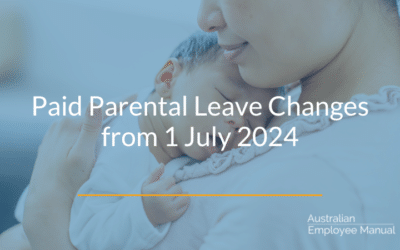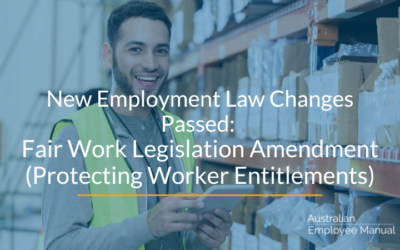One of the key changes arising from the Fair Work Legislation Amendment (Secure Jobs, Better Pay) Act 2022 relates to changes to fixed-term and outer-limit (also known as maximum-term) contracts.
A fixed-term contract is where you offer employment to a person for a specific time period. An outer-limit contract is where a contract has an end date, but the employer has the right to terminate the contract before that date.
While these types of contracts were designed to give employers flexibility in the workforce, what happened in many instances was these contracts were regularly renewed or extended at the end of the term on a rolling basis, creating defacto permanent employment without any of the benefits. This created job uncertainty for the individuals on the contracts.
The changes are designed to increase job certainty and permanent employment by compelling employers to offer genuine fixed-term arrangements or permanent employment.
These changes do not apply to casual workers – only part-time or full-time employees.
What Has Changed?
The Act introduced rules to limit the use of fixed-term and outer limit contracts to two consecutive contracts or a maximum duration of two years (whichever is the lesser):
- for the same role (or substantially similar work),
- where there is substantial continuity of employment during the period between the previous contract ending and the new contract coming into effect,
- where one of the contracts has an option for renewal or extension.
In other words, it prevents a fixed-term contract from being extended or renewed more than once for roles that are the same or substantially similar (even if that extension brings the total contract to less than two years).
Substantial continuity is not broken by the employee taking a short holiday or break between contracts. Another example where substantial continuity is not broken is sessional contracts in the higher education sector that finish at the end of one semester and start at the beginning of the following semester.
What Exceptions Are There?
There are several exceptions to these rules, including where the employee is engaged:
- as a casual employee,
- to perform only a distinct and identifiable task involving specialised skills,
- under a training arrangement,
- to perform essential work during a peak demand period, emergency circumstances, or during a temporary absence of another employee,
- on a contract where during the year in which the contract is entered into, the employee will earn above the high-income threshold for that year.
- to a position that is funded in whole or in part by government funding, and the funding is payable for more than two years but is not likely to be renewed at the end of the period,
- on a contract to a governance position that is time limited under the governing rules of a corporation or association,
- a modern award permits the use of fixed-term contracts in those circumstances and permits the term of the contract.
What Happens If You Employ Someone for More Than Two Years?
If an employer either extends the contract more than once or extends the contract for more than two years (whichever is the lesser), then the person becomes a permanent employee as the term of the contract is taken to have no effect.
They are then eligible for all the rights and entitlements of any other permanent employee, including redundancy and termination provisions, and have the right to pursue unfair dismissal claims.
The employer may also be subject to civil action, with fines of up to 600 penalty units for a serious contravention or 60 penalty units.
Anti-Avoidance Provisions
There are a raft of provisions spelled out to stop employers from trying to circumvent the new rules.
Employers are not allowed to do any of the following:
- Terminate an employee’s employment for a period.
- Delay re-engaging an employee for a period.
- Not re-engage an employee and instead engage another person to perform the same, or substantially similar, work for the person as the employee performed.
- Change the nature of the work or tasks the employee is required to perform.
- Otherwise alter an employment relationship.
Where another employee is hired instead of the original employee, as long as the intent behind the hiring was to try to get around the prohibition of consecutive contracts, the employer will be caught in the anti-avoidance provisions.
If the original employee challenges their non-engagement before the courts, it will be up to the employer to prove the decision was not made to try to circumvent the Act. In other words, employers need to have a high level of proof for their decisions.
Fixed Term Contract Information Statement
The Fair Work Ombudsman is preparing a new statement, and all employers must give a copy of this statement to any employee who enters into a fixed-term contract with them.
This statement must be given to the employee before or as soon as practical after they begin their contract with the employer.
When Do The Changes Come Into Effect?
These changes will take effect on 6 December 2023. This allows businesses 12 months to review their existing contracts, undertake workforce planning and adjust their recruitment practices over the coming year.
What Happens to Existing Fixed-Term Contracts?
While these changes don’t take effect until 6 December 2023, any contracts entered into before 6 December 2023 will be relevant in determining if the parties have subsequently entered into a prohibited contract.
What Should Employers Do Now?
Employers have 12 months until this section comes into effect. During that time, they should:
- Review their workforce to determine who is currently on a fixed-term contract and why they are on a fixed-term contract, not on permanent employment.
- Work out the circumstances when they will offer fixed-term contracts and contract renewals in the future.
- Review the length of contract renewal periods given that extensions (even for very brief periods such as two months) meant that further extensions can’t be offered.
- Review all fixed-term contract templates to ensure they comply with the new rules around multiple extensions or renewals.
We will be adding the requirement to provide a Fixed Term Contract Information Statement to our Employee Manual suite of products in the next update to our products.




